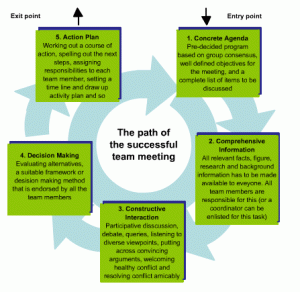There are reams of articles and book chapters devoted to the topic of running an effective team meeting but most of them address this issue from the perspective of the team leader or team manager. This article is addressed to the team rather than the team leader and puts forth some pre-requisites for a successful team meeting. This guideline is useful when the team members themselves set up a team meeting as part of their regular team process, with or without the presence of a team leader. The diagram below captures the path of the meeting and what the team members have to contribute along that path:

The above five points are essential for any team to be able to operate as a cohesive unit and run a meeting in a manner that delivers a desired output. The five points outline what a team should do both before and during a team meeting in order to translate their deliberations into a successful and fruitful exercise. As shown in the diagram, every meeting has an entry point, followed by a main segment and then an exit point.
The entry point is the Concrete Agenda with access to Comprehensive Information that is necessary for the meeting to be effective. All information should ideally be made available prior to the meeting so that every member on the team comes prepared for the discussion. At the meeting, the team members can update one another on any new or additional information that is relevant to the discussion. The middle segment is the core of the meeting and comprises the main discussions. It involves Constructive Interaction and is followed by the process of Decision Making. And finally the exit point is a firm Action Plan.
Certain other factors also come into play during the meeting. For instance, the ground rules and the rules for team behaviour that all the team members subscribe to, are equally important during a meeting. These ground rules are usually set when the team is initially formed and are put in place to facilitate smooth interaction and operation within the team. These rules are especially relevant during the meeting process.
Examples of Ground Rules:
- Politeness and courtesy
- Constructive comments
- Supportive attitude
- Cooperation
- Sharing and collaborative disposition
- Maintaining a positive work environment within the team
- Listening ability, respect and fair play
The last point is especially relevant during team meetings. Team members have to abide by a team-work ethic where everybody gets a fair chance to air their views. Team members have to give one another a patient hearing. This work ethic ensures that everybody on the team participates in meetings, and is an equal partner in the team discussions. The team meeting is a major determinant in team performance and team success. Unless the team is able to interact, discuss, thrash out issues, and use their problem solving capacity optimally, the team mission is bound to suffer. The team meeting should proceed in a manner that takes their common purpose forward. The path to a successful team meeting, explained here, is meant to help teams in that endeavour.
Reference: ‘How to be a better Teambuilder’, Rupert Eales-White
The Art of Being a Productive Player in Team Meetings
More information on partner relationship management.
 Team Building Portal
Team Building Portal